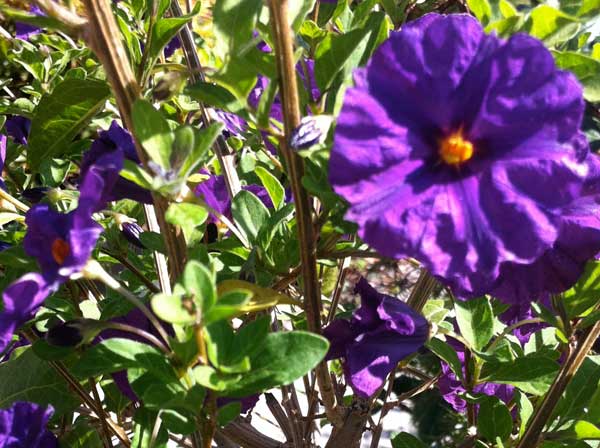Lycianthes rantonnetii ‘Royal Robe,’ also known as Solanum rantonnetii, Blue Potato Bush, or Paraguay Nightshade, is a fascinating plant belonging to the Solanaceae family. This species is native to South America, specifically Paraguay and Argentina. With its relation to potatoes, Lycianthes rantonnetii was previously classified under the name Solanum rantonnetii.
Lycianthes rantonnetii is an evergreen shrub that thrives in tropical climates. It showcases beautiful fragrant violet flowers that add a touch of allure to any landscape. The plant features oval-shaped bright green leaves, creating an attractive backdrop for its striking blossoms. Known for its fast growth, Lycianthes rantonnetii can reach an impressive height of 12 feet or 3.6 meters, potentially requiring some support to maintain its sturdy posture.
In terms of flowering, Lycianthes rantonnetii graces the garden with its vibrant blooms during the summer and autumn seasons. The flowers grow in clusters, displaying a distinctive funnel shape. They exhibit a captivating blue-violet hue, with eye-catching yellow centers that enhance their overall charm. It’s worth noting that Lycianthes rantonnetii blooms on the previous year’s growth, adding to its unique growth pattern. Following the flowers, the plant produces small red berries, contributing to its visual appeal.
How to grow Lycianthes rantonnetii ‘Royal Robe’:
To successfully cultivate Lycianthes rantonnetii, consider the following guidelines:
Climate: In milder climates, it is suitable to plant Lycianthes rantonnetii outdoors. However, in regions with harsh winters, it is recommended to grow this plant indoors in containers, such as a cool greenhouse, where it can receive sufficient protection.
Sunlight and Shelter: Lycianthes rantonnetii thrives in full sun exposure but benefits from some shelter against strong winds, which can damage its delicate foliage and flowers.
Soil Requirements: Plant Lycianthes rantonnetii in moist, well-drained soil. It is adaptable to both alkaline and acidic soil conditions, ensuring greater flexibility in choosing a suitable planting location.
Pruning: Light pruning in early spring is recommended for Lycianthes rantonnetii. Trim the plant to shape it and remove any dead or damaged branches, promoting healthy growth and maintaining an appealing appearance.
Pest and Disease Management: Keep an eye out for potential issues such as grey molds, aphids, or red spider mites, particularly when growing Lycianthes rantonnetii indoors or in a greenhouse. Regular monitoring and appropriate pest control measures can help maintain the plant’s health.

Propagation:
This species can be propagated through seeds or semi-ripe cuttings during the summer or autumn seasons. For successful growth, ensure the propagation method is carried out correctly.
Lycianthes rantonnetii is known to attract butterflies, bees, and birds, enhancing the biodiversity and vibrancy of your garden space.
Lastly, it is essential to note that Lycianthes rantonnetii is heat-tolerant and deer-resistant, making it a suitable choice for regions with warm climates and wildlife presence. However, it is crucial to exercise caution as the plant is toxic if ingested, causing discomfort if consumed.
By following these detailed guidelines, you can successfully cultivate Lycianthes rantonnetii ‘Royal Robe,’ relishing its evergreen foliage, fragrant violet flowers, and the wildlife it attracts. Whether grown outdoors or in containers, this species will add charm and visual interest to your garden while providing a unique touch of South American beauty.




